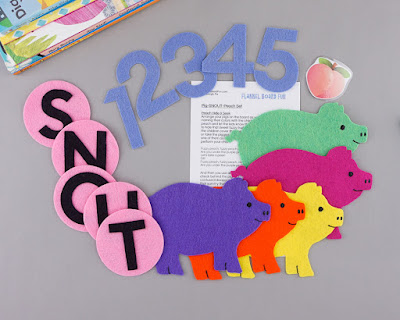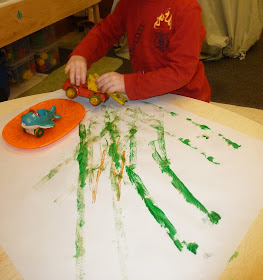Does finger painting bring back childhood memories for you? It does for me, and they're all good ones! I loved the smell of the paint, the cool, slick feel of it, the bright colors mixing together... Which no doubt influenced me to offer finger painting pretty frequently as a teacher. I wanted my students to have those same fond memories, and I think they will :)
Finger painting is one of the few art experiences that really does work best with a smock of some kind, because the kids really lean into the tray of paint more than they do in any other painting activity. I generally avoid smocks, as they often discourage a child from participating, and honestly I haven't found any that actually keep paint off the kids! But our school had t-shirts made for a fund raiser, so I took some of the leftovers, a couple sizes too big for my kids, and turned them into finger painting smocks. T-shirts aren't foreign to kids, so they aren't as disturbed at putting them on!
My favorite way to present the finger paints is on a big, round, shallow tray. Ask them what colors they want, and where they want their blobs plopped down. Then let them go to town!
Of course you can also add paper. I often don't bother--it really is about the process, not a product--but sometimes they ask for it, and sometimes it's just fun to show them how they can make prints. Just let them do their own thing, and everything turns out great :)
Not to be dismissed is fingerTIP painting! This is great for kids who don't want their whole hand covered in paint. We put a wet rag nearby for anyone needing an extra wipe now and then :)
So many benefits come from finger painting: Color mixing is science! Stress floats away! Finger and hand muscles get stronger! Awareness of cause and effect grows! Self-help skills abound at clean up time! Sensory integration occurs!
Do you have fond memories of finger painting? Share them in the comments below!






























